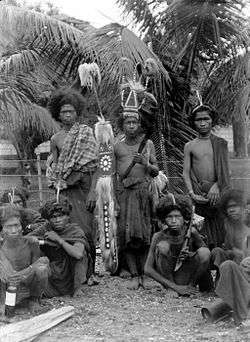Lamaholot people
The Lamahalot or Solorese people are an indigenous tribe located on Flores Island, Indonesia, and some smaller islands around it (Solor, Adonara, and Lomblen). Lamaholot people speak the Lamaholot language with different dialects, the number of speakers counts between 150,000 and 200,000.[2]
 Young men of Solor in military costume, East Flores. | |
| Total population | |
|---|---|
| 193,000[1] | |
| Regions with significant populations | |
| Languages | |
| Lamaholot language, Lewotobi language, Adonara language, Larantuka Malay, Indonesian language | |
| Religion | |
| Roman Catholicism (predominantly), Islam, Folk religion | |
| Related ethnic groups | |
| Manggarai, Sika |
Lamaholot people's famous traditional dance is a war dance known as Hedung.[3]
History
Since the 16th century the territory of the Lamaholot was the object of the claims of the Sultanate of Makassar, Portugal and the Netherlands. Until the middle of the 19th century Lamaholot were under the Portuguese colonial administration, then under the Netherlands in 1859-1942, and until the middle of the 20th century they were formally submitted to the Rajas of Larantuka and Adonara.
Language
The Lamaholot language belongs to the Malayo-Polynesian languages of the Austronesian languages family. The language is divided into many dialects, the most common are the Western Lamaholot (Muang and Pukaunu), Lamaholot (Taka, Levotaka, Mandiri Island), and Western Solor. Language is a means for wide communication between the numerous ethnic groups living in the area around Larantuka and Solor. On the island of Flores, the Lamaholot people speak Bahasa Nagi (Larantuka Malay)[4] and Mandarut language, a dialect of the Malay language.
Religion
Most Lamaholot people are Roman Catholics.[5] Some of them are Muslims or devotees of a traditional monotheistic religion who believe in a god whom they call Lera Wulan Tanah Ekan (The combined power of the Sun, Moon, and Earth),[6][7] death cults and shamanism. The Lamaholot people also preserve rich verbal and musical folklore.
Family
Traditional social organization is strictly based on patrilineal birth.[8] They also maintained a characteristic of descent line that divides into "origin groups" or phratries.[9] Marriages occur across on the matrilateral side, with a marital settlement of Patrilocal residence.[8] The family unit is small.
Economy
The main occupation is manual tropical farming. Dominant agricultural crops are such as corn, dried rice, millet, yam, cassava, sweet potato, legumes, pumpkin, various fruits and vegetables. Fishing is developed on the coast. Livestock plays an auxiliary role. The main dietary food includes boiled corn and rice with vegetable and fish seasonings. Residents of a number of coastal villages specialize in intermediary trade in textiles, clothing and agricultural implements. In the Lamalera village on Lomblen island and Lamakera village on Solor island, whaling is developed.[10]
Lifestyle
Traditional cumulus settlements (in the mountains) are surrounded by a dense hedge of corals, houses are skeleton-pillared, rectangular, with a high steep roof. Before the beginning of the 20th century, there were long houses. Modern settlements are coastal farms, the dwelling is designed for a small family. They also adopt Malay-style clothing.[11]
References
- "Lamaholot, Solorese in Indonesia". Joshua Project. Retrieved 2015-01-18.
- Nishiyama, Kunio; Kelen, Herman (2007). A Grammar of Lamaholot, Eastern Indonesia: The Morphology And Syntax of The Lewoingu Dialect. Lincom Europa. ISBN 978-3-89586-714-9.
- S. Peku Djawang (1987). Mosaik Pariwisata Nusa Tenggara Timur. Dinas Pariwisata Propinsi Daerah Tingkat I Nusa Tenggara Timur.
- Karen Nelson (2013). Attending to Early Modern Women: Conflict and Concord. University of Delaware. p. 136. ISBN 16-114-9445-1.
- "Lamaholot people". Joshua Project. Retrieved 2014-09-16.
- Wayan Agus Purnomo (21 November 2015). "WISATA PANTAI: Legenda Naga Kepala Tujuh di Laut Flores". Tempo. Retrieved 2016-11-01.
- Urte Undine Frömming (2006). Naturkatastrophen: kulturelle Deutung und Verarbeitung. Campus Verlag. ISBN 35-933-8004-8.
- John L. Comaroff (1980). The Meaning of Marriage Payments. Acad. Press. p. 97. ISBN 01-218-3450-6.
- Nancy Melissa Lutz (1986). Authoritative Discourse: Language and Ideology in Adonara, Eastern Indonesia. University Microfilms. p. 114.
- Kathryn Monk & Yance De Fretes (2012). Ecology of Nusa Tenggara. Tuttle Publishing. ISBN 14-629-0506-4.
- Бернова А. А. & Членов М. А. (1999). Тишков В.А. (ed.). Народы и религии мира. Энциклопедия. М.: Большая Российская энциклопедия.